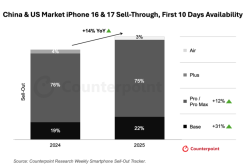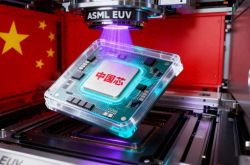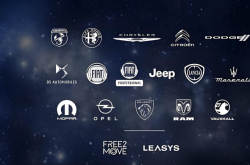Can Shenzhen's robot industry, which quietly does great things, great again?
![]() 03/07 2025
03/07 2025
![]() 629
629

History is always so tumultuous:
After performing yangko dance on Spring Festival Gala, humanoid robots became a hit, overshadowing Xiao Shenyang of that year and attracting the attention of Goldman Sachs. Then Goldman Sachs conducted research at Unitree Robotics and found that the inflection point of humanoid robot technology was still unclear. The relevant sector index fell accordingly.
However, in the past few days, the robot sector has rebounded. On March 3, Shenzhen-based UBTech unveiled the "swarm intelligence" ace of humanoid robots, with dozens of humanoid robots performing collaborative tasks such as sorting, handling, and precision assembly in the ZEEKR factory. This news boosted market confidence, and UBTech's share price has risen for multiple consecutive days.
Citi's latest report points out that UBTech's shareholder background and cooperation with leading Chinese new energy vehicle companies such as BYD may help boost its humanoid robot business. Its current valuation can be compared to Tesla's level during the nascent stage of new energy vehicles in 2010-2011 – when Tesla Roadster's annual delivery was only 1,500 units, but its price-to-sales ratio was as high as 24 to 25 times. This is equivalent to directly telling the market:
UBTech is the next Tesla.
Why did the robot sector fall and then rise again? Both are international investment banks, so why is there such a big difference? Gulf Stream Economic Review believes that performance is not the core value of humanoid robots; application landing is. While humanoid robots in Hangzhou are still dancing and showing off their skills, humanoid robots in Shenzhen have already adopted swarm intelligence and are exploring large-scale applications.
Nowadays, the humanoid robot industry is on the eve of an explosion. This year's government work report clearly proposes to develop new productive forces, establish an investment growth mechanism for future industries such as embodied intelligence, and vigorously develop new-generation intelligent terminals such as intelligent robots and intelligent manufacturing equipment, further accelerating the development of this industry.
The future is here, and the show is exciting!
01
Goldman Sachs throws cold water
Goldman Sachs' report is concise, with only one page. After a few polite words, it immediately changes tack:
1. Unitree Robotics' humanoid robot H1 only has 19 degrees of freedom, so it cannot handle complex and delicate tasks;
2. The robot dog equipped with a large language model does not yet have the ability to operate completely autonomously;
3. As its capabilities are not yet sufficient to handle multiple general tasks, the inflection point of humanoid robot technology remains unclear. AI-enabled robots may need to wait longer.
The central idea of this report is straightforward:
It does not focus on showmanship but on the working capabilities of humanoid robots.
Who is Goldman Sachs? A legendary investment banking giant on Wall Street, whose every move can influence the development or even survival of an industry. Therefore, when the report was released, the humanoid robot sector fell accordingly. On February 28, the index of the humanoid robot concept sector fell by more than 7%, and multiple concept stocks hit the daily limit down.
Is Goldman Sachs right?
Absolutely. From a commercial value perspective, the ability to apply is the true value, which is an unchanging truth.
But is Goldman Sachs' conclusion completely correct? Is the market's reaction correct?
This is exactly what Gulf Stream Economic Review wants to say – Goldman Sachs may have a biased view of the current development status of Chinese humanoid robots, and the market may have misunderstood Goldman Sachs' meaning.
02
Overreaction of the market
First of all, the market is overgeneralizing. Goldman Sachs' research on Unitree Robotics does not equal the entire Chinese humanoid robot industry. China's humanoid robot industry is not limited to Unitree Robotics; it is only one of the representative players in this field. Its capabilities do not represent the capabilities and technical focus of all humanoid robot manufacturers. Whether it's Unitree Robotics' H1 or G1, the characteristics of both products lie in their strong motion control capabilities, which is also one of Unitree Robotics' genes.
To understand China's humanoid robot industry, one must look at Shenzhen! Shenzhen is the king of robots in this regard, a "No.1 City for Robots" that integrates multiple "No.1s":
In 2023, the robot output value was 179.7 billion yuan, ranking first in China;
There are 51,100 existing robot-related enterprises, ranking first in China;
There are 34 listed robot companies, ranking first in China...
Shenzhen-based UBTech is the world's first publicly traded humanoid robot company; Shenzhen-based UFACTORY is China's first publicly traded collaborative robot company...
Secondly, the working capabilities of humanoid robots that Goldman Sachs desires can be achieved by Shenzhen enterprises!
Humanoid robots are not just a "concept" but a new productive force, which is an indisputable fact.
UBTech conducted the world's first collaborative operation of multiple humanoid robots in multiple scenarios and tasks at the ZEEKR 5G Smart Factory. Dozens of humanoid robots performed collaborative tasks such as sorting, handling, and precision assembly in complex scenarios such as the final assembly workshop, SPS instrument area, quality inspection area, and door assembly area.
To address the challenges of industrial scenario production line-level tasks for multi-robot collaborative operations of humanoid robots, UBTech conducted research on swarm intelligence technology and innovatively proposed a humanoid robot swarm brain network software architecture. Through the flexible linking of reasoning nodes and skill nodes through end-cloud collaboration, it forms a "super brain" and "intelligent cerebellum" at the group dimension, enhancing the robots' efficient collaboration capabilities in complex industrial environments and laying the foundation for efficient collaboration of humanoid robots in such environments.
Based on DeepSeek-R1 deep reasoning technology, UBTech has developed the world's first large-scale multimodal reasoning model for humanoid robots. As the core engine of the super brain, it drives the continuous self-evolution of the swarm brain network architecture, thereby unleashing swarm intelligence. More importantly, this also marks the transition of humanoid robots from stand-alone autonomy to swarm intelligence, further promoting the application of humanoid robot technology in the industrial field.
03
Shenzhen robots are always great
By the way, saying that "Shenzhen has no innovation after DJI" is far from the truth. Because Shenzhen's robot industry has unparalleled advantages in industrial chain integration and technology commercialization, and it also shoulders the responsibility of winning the great power technology war, it will always be great...
First is industrial chain integration.
The Greater Bay Area is known for its complete industrial chain, and the robot industry is no exception.
Shenzhen's robot industrial chain has a high localization rate, exceeding 60%. This figure reflects Shenzhen's strong self-sufficiency in the robot industry and low dependence on external supplies, ensuring considerable resilience in the robot industry. Costs have also been controlled and optimized, while technological levels have been improved.
At the same time, Shenzhen has truly mastered the core technologies of robots and has made significant breakthroughs in key core components, AI chips, multimodal perception technology, and high-precision motion control technology for robots.
Second is the smooth path of technology commercialization.
The Shenzhen government takes this aspect seriously. The recently issued "Shenzhen Action Plan for Technological Innovation and Industrial Development of Embodied Intelligence Robots (2025-2027)" clearly focuses on building a public service platform matrix, an innovation service platform, promoting standard system construction and intellectual property protection, supporting the application of first-of-its-kind products and the cultivation of popular products, accelerating the opening of application scenarios, and comprehensively fostering the commercialization of the robot industry. It plans that by 2027, Shenzhen will make breakthroughs in key core components, AI chips, AI and robot fusion technology, multimodal perception technology, high-precision motion control technology, dexterous manipulation technology, and other aspects of robots, and will cultivate more than 10 enterprises with a valuation of over 10 billion yuan, more than 20 enterprises with revenue exceeding 1 billion yuan, realize the landing of more than 50 application scenarios worth billions of yuan, achieve a related industry scale of over 100 billion yuan, and have more than 1,200 enterprises related to the embodied intelligence robot industrial cluster.
Shenzhen has also attracted a large number of upstream and downstream enterprises, research institutions, and innovation teams to join by building a public service platform matrix, forming a relatively complete industrial ecosystem. For example, the Shenzhen Institute of Artificial Intelligence and Robotics focuses on research in three major directions: "multi-scale lumen interventional surgical robots," "heterogeneous multi-robot agile collaboration systems," and "AI-driven smart and low-carbon." The Futian Laboratory focuses on embodied intelligence in the human living environment.
In addition, the application scenarios are quite rich, covering various fields such as industrial manufacturing, healthcare, education, and public safety. For example, UBTech's Walker S series robots have cooperated with Shenzhen-based new energy vehicle company BYD and 3C electronics precision manufacturing company Foxconn to jointly explore the application of humanoid robots in intelligent manufacturing scenarios.
This also qualifies for Huang Renxun's praise:
The Greater Bay Area is the only region that simultaneously possesses electromechanical technology and AI technology, providing unique conditions for the development of the robot industry.
Only by combining the above factors can start-up robot enterprises cross the Valley of Death and go public. Therefore, many people think that Shenzhen only knows how to "make money," but they don't realize that using technology to make money is the hardest thing, and making money with technology is the coolest thing.
Moreover, contrary to many people's perceptions, Shenzhen enterprises also bear the responsibility of winning the Sino-US technology war. There is a significant difference between the founders of technology enterprises in Shenzhen and Hangzhou. The former focus on technological breakthroughs, while the latter are more concerned about how to make money at a low cost. In the words of Yuan Gangong, Shenzhen wants to "win," while Hangzhou wants to "make money."
Therefore, in the past two years, the United States has directly targeted Huawei and ZTE in Shenzhen because the technologies of these two companies truly scare them.
While enterprises in Hangzhou become internet celebrities and gain traffic, enterprises in Shenzhen still have to forge ahead with a heavy load to wipe away the disgrace of the past.
The application of humanoid robots in the field of intelligent manufacturing has become a new high ground for global technological competition. The world's top three humanoid robot companies, UBTech, Tesla, and Figure, are all making humanoid robots work in factories.
Leveraging China's industrial advantages in intelligent manufacturing, especially new energy vehicles, UBTech's industrial humanoid robot Walker S series has entered the most car factories for practical training and has achieved the world's first case of swarm intelligence operations with multiple robots, in multiple scenarios, and for multiple tasks.
Figure has cooperated with BMW to have humanoid robots perform automotive assembly work on automobile assembly lines. It recently released the end-to-end Helix system based on vision-language-action (VLA) and announced that the company's humanoid robots have learned to take a second job: sorting express packages in logistics centers.
Musk, who is frantically making humans, is also frantically making robots, planning to deploy thousands of Optimus humanoid robots in Tesla factories by the end of 2025. Musk also said:
The popularity of humanoid robots will be 10 times higher than that of cars.
Therefore, facing international competition, the best way is for more humanoid robot enterprises to explore the true value of technology with great concentration and join forces to win the great power technology war together!
Reference materials:
Baopu Finance and Economics: With the highest output value and the most listed companies, Shenzhen is the "No.1 City for Robots
Sohu Technology: Can Shenzhen great again?
Yuan Gangong: Shenzhen wants to "win," while Hangzhou wants to "make money"








